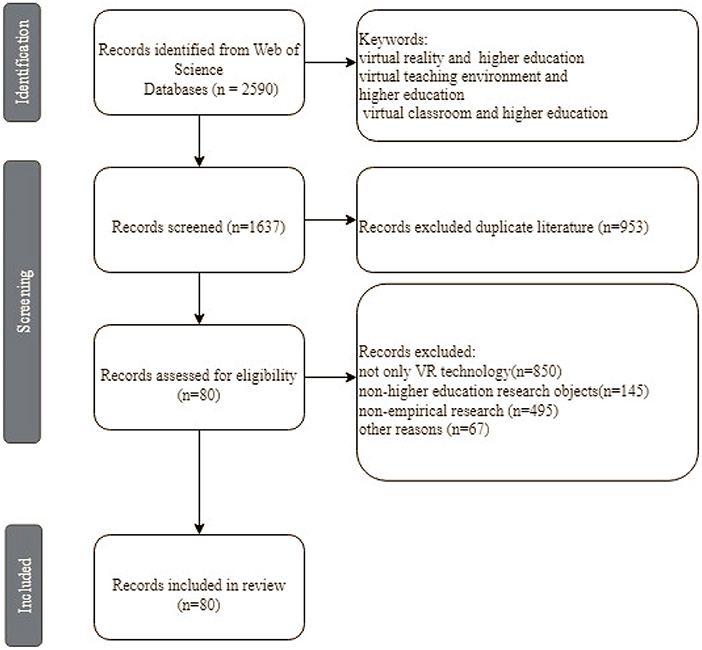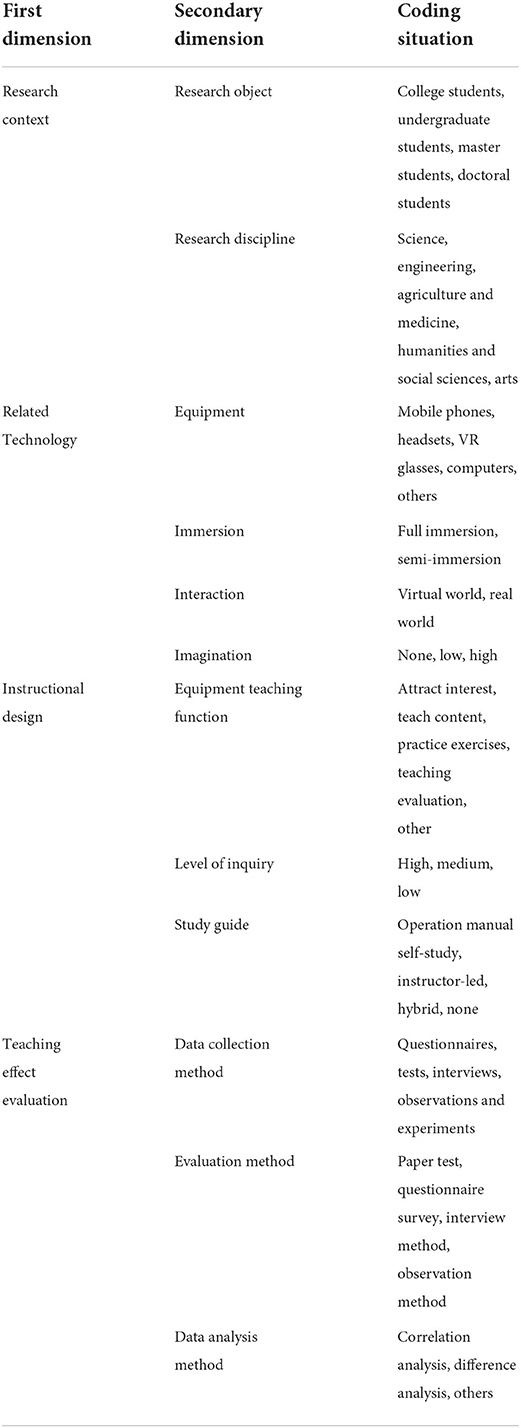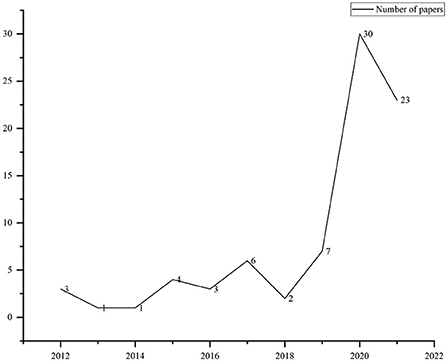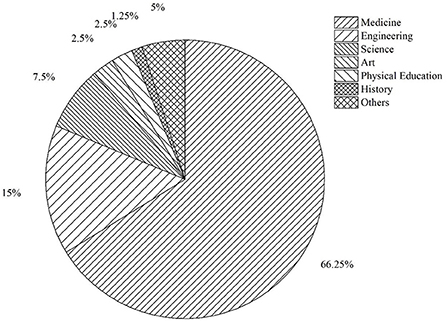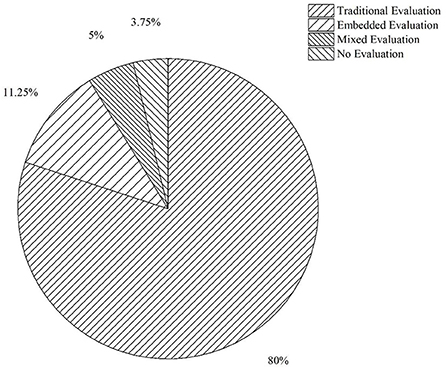- Department of Educational Technology, Faculty of Education, Fujian Normal University, Fuzhou, China
In recent years, with the rapid development of information technology, the visualization and interaction of virtual reality technology has developed, making the application of VR technology in education more and more attractive to scholars. This paper adopts the literature analysis method, focusing on the application of VR technology in the field of higher education, selects 80 empirical studies in the Web of Science literature database, conducts in-depth reading and analysis of the papers, and summarizes the experience of applying VR technology in the field of higher education. In order to deepen the application of VR in higher education. The research results show that the research objects of VR application in higher education are mainly undergraduates, the main majors of application are science, engineering and medical related majors, and the application of humanities and social sciences is relatively rare. At present, the devices used for VR in higher education are mainly computers and headsets, which are not portable enough. In addition, students lack guidance and training in the use of VR equipment before class. Compared with traditional education, most of the studies show that the application of VR to higher education and teaching has positive effects, mainly by affecting students' behaviors to affect students' learning results. The researchers mainly use traditional evaluation methods to evaluate teaching effects, use questionnaires and tests to collect data, and use data analysis methods mainly difference analysis and descriptive analysis. Based on the research results, the researchers put forward some suggestions at the end of the paper.
Introduction
VR is also called artificial environment. The definition of modern VR technology is using complex technology to form synthetic stimulation to replace real-world sensory information, which means that users enter the virtual scene and use special helmets, data gloves, or input devices such as keyboards and mice to interact with the virtual environment in real-time. VR can make the user feel like they are in a real environment (Shin, 2018). The core VR originated in the 1960s. In the early 1990s, the Interactive
Systems Project Working Group funded by the National Science Foundation of the United States made a systematic discussion of VR. But due to the underdeveloped technical equipment at that time and the high cost of VR-related equipment, VR technology has not been developed for a long time. Later, with the rapid development of technology and the emergence of affordable VR headsets and other devices for games and entertainment, VR ushered in the second spring. At present, a new generation of information technology represented by VR technology has been widely used in the field of education. VR can provide students with teaching aids that are closer to real life, rich and diverse personalized learning environments, and change the boring traditional classrooms. Students are also provided with opportunities for active exploration and interactive communication to promote active learning. Additionally, VR has been described as a learning aid for the 21st century (Rogers, 2019), with a study showing that students retain more information and are better able to apply what they learn after engaging in VR exercises (Krokos et al., 2019). With the use of VR to enhance potential learning, it is understandable why researchers, organizations and educators are now paying close attention to the technology.
Although the application of VR technology in education is not new, the development of VR technology in visualization and interaction in recent years has made the application of VR technology in education more and more attractive to scholars, especially in higher education field. The core characteristics of VR are immersion, interactivity, and imagination, and these three characteristics make VR a huge advantage in the field of higher education (Ryan, 2015). First of all, VR has immersion, using this technology can build a realistic virtual environment, students are immersed in it. Second, VR is interactive. In the VR environment, when students perform operations, the environment will give students corresponding feedback, and interaction can deepen students' impression of the classroom and master knowledge more efficiently. Third, VR has imagination, students can deeply understand related issues according to their own senses, cognitive methods and cognitive ability in the simulated VR environment, which also can expand students' innovative thinking awareness and effectively enhance students' creativity and imagination.
Due to the increasing attention of the academic community to VR technology, there have been some comprehensive overviews and systematic reviews of VR educational applications, but the research of many scholars has the following problems. First, many scholars have put together virtual reality, augmented reality and mixed reality to study the application of education in education (Alalwan et al., 2020; Duarte et al., 2020). Second, most of the research on the application of virtual reality technology to higher education starts from a theoretical perspective and studies the possibility of virtual reality technology in certain disciplines in the field of higher education, and there are few empirical studies (Moore, 1995; Hoffman and Vu, 1997). Finally, most of the current research reviews are aimed at a certain discipline or a certain course of higher education, and few researchers have comprehensively analyzed the overall application of VR technology in higher education.
This study focuses on the application of VR technology in the field of higher education. Through the analysis of the Web of Science database literature, it comprehensively analyzes the application and existing problems of VR technology in higher education, and summarizes the application of VR technology in higher education. Finally, some suggestions are put forward to deepen the application of VR in higher education. This research mainly focuses on the following questions:
Q1: Which majors in the field of higher education are VR mainly applied to, and what are the trends or characteristics?
Q2: What are the main VR devices currently used in higher education?
Q3: Compared with traditional education, what is the teaching effect of VR in higher education and what aspects mainly affect the teaching effect? What methods do scholars mainly use to evaluate the teaching effect of VR in higher education?
Q4: What research methods are used to study the application of VR in higher education, and what data collection methods and data analysis methods are mainly used by researchers?
Research methods
This paper's research method the literature analysis method. The literature analysis method refers to an analysis method through which the collected literature data of a specific subject is studied to find out the nature or situation of the research object, and draw the researcher's point of view from it. This research method is the most commonly used research method in literature review. The main steps of this research are: first, determine the topic of application of virtual reality technology in higher education; second step, collect and screen relevant literature according to the literature inclusion rules of this study; third step, carry out historical analysis and research context of the literature Analysis, analysis of research results and analysis of research methods; Finally, write a review.
Data sources and screening methods
This study reviewed the literature on the application of VR technology in higher education in the past 10 years (2012–2021), and the main database used in this study is Web of Science, and IEEE and Google Scholar are supplementary databases. The reason for choosing Web of Science as the main database is that the database has a strong interdisciplinary nature, which is consistent with the theme of this study. Two groups of keywords are used in literature retrieval. Keywords related to virtual reality technology are virtual reality, virtual teaching environment, virtual classroom. Keywords related to higher education is higher education. The keywords of the two groups are combined as search characters. The time span of the literature was set from January 1, 2012 to December 31, 2021, and 2590 related literatures were retrieved. During the analysis of this study, the following criteria were used for the inclusion and exclusion of literature: (1) Only empirical research on the application of VR in advanced fields was included, and research results such as review papers and conference abstracts were excluded. (2) The technology used in the research must be VR, and the literature on augmented reality and mixed reality is excluded. (3) The object of the research must be the object of higher education, which means that including junior college students, undergraduate students, master students, and doctoral students. According to the above principles, a total of five researchers participated in the literature screening. After three rounds of screening, the researchers finally took out the uncertain literature and discussed them together, and finally got 80 relevant literatures. The literature screening flowchart is shown in Figure 1.
Code analysis method
This paper uses the coding table shown in Table 1 to quantify the 80 documents obtained by screening. Table 1 is divided into three first-level dimensions, namely research context, related technology and teaching effect evaluation. Each first-level dimension is divided into 2–4 second-level dimensions.
Results
Analysis of the annual distribution of literature
Statistical statistics of the 80 selected literatures were carried out, and the trend graph of the number of empirical literatures with years was obtained as shown in Figure 2. The horizontal axis represents the year, and the vertical axis represents the number of articles per year. Observing Figure 2, we can see that from 2012 to 2017, researchers were not enthusiastic about the application of VR in higher education, but from 2018, the number of papers published showed a clear upward trend. The number of papers published in 2020 has reached its peak in the past decade, reaching ten times the number of papers published in 2012. To analyze the reasons, the first is the development of VR technology. After 2018, VR technology has matured, and the price of related equipment has become relatively cheap, and many colleges and universities have been able to purchase equipment. Second, since the outbreak of the new crown epidemic from the end of 2019, many college students have been unable to enter the school to study due to other reasons such as being in a risk area or the school is in a risk area, but the practical skills of college students must be mastered in the syllabus, so the researchers turned their attention to VR technology. Its 3I characteristics can just solve the problem, allowing students to complete related skills training without returning to school.
Analysis of the research context
The empirical research papers are classified to obtain a statistical graph of VR applied to related majors in the field of higher education, as shown in Figure 3. Observing Figure 3, it is obvious that VR technology is widely used in medical education in the field of higher education. Among the 80 literatures, there are 53 empirical studies on medicine, accounting for 66%, followed by engineering, Science, Physical Education, Art, History and others. In addition, VR technology can also be applied to the teaching of higher education open courses and other skills training, such as ideological and political teaching, English teaching and speech training. After classifying the research objects, it is found that the research objects of VR technology application and higher education are mainly undergraduates. Among the 80 literatures, 77 research objects are undergraduates, 3 are graduate students. The number of empirical studies taking junior college students and doctors as research objects is 0. Higher medical education is an important part of higher education and shoulders the important mission of cultivating medical talents and maintaining and promoting human health. Using VR technology can help medical students to repeatedly train their skills without considering the issue of experimental resources. For example, Jung et al. integrated VR technology to learn basic skills of laparoscopy, students repeatedly learned the basic skills of operation through the laparoscopic simulator (Jung et al., 2012). In addition, VR technology can also help medical students improve their empathy skills, so that they can treat patients in a more appropriate way. For example, some researchers have applied VR technology to elderly nursing teaching, and the results show that students show higher understanding and empathy for elderly people with aging diseases such as macular degeneration and hearing loss (Dyer et al., 2018). Immersive VR courses have improved medical students' ability to assess patients with dyspnea (Zackoff et al., 2020), allowing timely escalation of care for patients with signs of respiratory failure. There are some necessary skills that need to be mastered in the teaching objectives of science and engineering majors in higher education. Researchers can use VR technology to conduct virtual training or virtual experiments. Virtual practical training is skill training in a virtual environment, such as applying VR technology to welding courses. The research results show that most students' final exam scores for welding practice are significantly higher than their mid-term exam scores, and students' learning effect on VR-assisted welding courses is also high. Expressed an obvious affirmation (Huang et al., 2020); Applying VR to machine tool training, the results show that the effect of machine tool training in virtual environment is greatly improved (Chen et al., 2019). Compared with the training room in the real environment, virtual training can not only save teaching costs and avoid safety risks, but also stimulate students' interest in learning, turn students into subjects, and promote students' active learning. Virtual experiment is to imitate the virtual environment to conduct experiments, such as physics and chemistry experimental teaching due to site restrictions or dangers cannot carry out practical operations, students can use VR equipment to conduct experiments. It can be seen from the research results that the main target of VR application in the field of higher education is undergraduates, the majors of application are mainly science, engineering and medicine-related majors, and the application of humanities and social sciences such as history and art is relatively rare.
Research on VR equipment
The main devices for VR applications in the field of higher education include computers, headsets, VR simulators, mobile phones and so on. Computers are the main equipment for VR applications in higher education. Through computers, virtual laboratories can be made, VR games can be developed, and so on. The VR head-mounted device uses the head-mounted display device to block people's vision and hearing of the external environment, and guide the user to have a feeling of being in a virtual environment. Head-mounted virtual reality devices can bring an excellent real experience, making the content in the book touchable, interactive, and perceptible. VR headsets can be divided into three categories: external headsets, all-in-one headsets, and mobile headsets. VR simulators are the main equipment for VR applications in higher education. The latest VR head-mounted displays, the HTC Vive and Oculus Rift, not only allow users to experience a high degree of immersion, but also provide interactivity. VR headsets generally have a Bluetooth connection function, and users can experience
interaction by operating Bluetooth devices such as external controllers. The advantage of this type of interaction is that the handle operation is more familiar to the user. In addition, the range of motion of such equipment is small, and the comfort level will be increased. However, the current type of external Bluetooth handle device also has some disadvantages. For example, there are too many buttons, and many buttons in the device cannot be used by the user; the operation is unreal. In the real world, if you want to pick up something on the ground, the user needs to squat down and open his palm, but in the virtual world, it can only be achieved by moving a finger and pressing a button, which is a bit contrary to the immersion of VR equipment. VR equipment is divided into three categories: non-immersive - desktop VR such as some 3D interactive animation; immersive - cave-based VR such as immersive experience under the surround wall screen in a closed room and fully immersive - full Immersive VR systems such as Google Cardboard. This study compares VR devices according to the classification of VR device immersion in the literature.
In this study, VR simulators mainly refer to medical simulators, which are mainly used for basic teaching and skill training in medical education. Typical simulators include laparoscopic simulators, oral simulators, clinical puncture simulators, and so on. Traditional medical training is based on see one, do one, teach one model. However, this traditional model does not work in the world of modern medical technology. For example, laparoscopic VR simulators allow medical students to perform training in laparoscopic and gynecological surgery in a hyper-realistic and risk-free environment (Mulla et al., 2012); Oral simulator Moog simodon allows medical students to conduct repeated training of dental restoration skills in the event of accidental injury (Murbay et al., 2020). Scientific studies have proven that the application of simulators greatly improves training results compared to traditional methods. A high-quality simulation experience allows trainees to lessen their doubts and immerse themselves in the training scenarios. For example, if a virtual patient bleeds suddenly during training, its performance can be visually and sensory enough for the doctor to feel real enough for the trainee to engage in the training to find a quick solution. The laparoscopic simulator can also record trainee behavior with millimeter precision, which can provide valuable feedback not only on how the trainee is performing during the procedure, but also on the potential behavioral outcomes of the simulated patient.
Compared with VR headsets, mobile phones are more portable. The combination of mobile phones and VR glasses creates a VR environment, and students can access the system through mobile terminals for learning. For example, Kader et al. created a VR crime scene activity through Web VR software such as Uptale, where students can participate remotely through mobile devices to investigate virtual reality crime scenes and collect evidence for subsequent analysis (Kader et al., 2020). This paper conducts statistics and analysis on the VR devices used in the obtained 80 literatures, and the statistical results are shown in Figure 4. Looking at Figure 4, it can be seen that the number of VR devices in 2017–2021 has increased significantly compared to 2012–2016. In the 5 years from 2012 to 2016, the main device for VR application in higher education was the computer, followed by simulators, head-mounted devices, etc. However, in the 5 years from 2017 to 2021, headsets have become the main equipment for VR applications in higher education, and the proportion of teaching using VR simulators has also been greatly reduced. Analyzing the reasons, due to the rapid development of science and technology, researchers are more inclined to use devices with lower prices and higher interactivity, which can make users highly immersed in the virtual environment. In addition, according to the results of literature analysis, it is found that many studies are biased toward practical application, and lack relevant standards for technical index evaluation and operating environment evaluation. This part of the content deserves in-depth attention of researchers in the future.
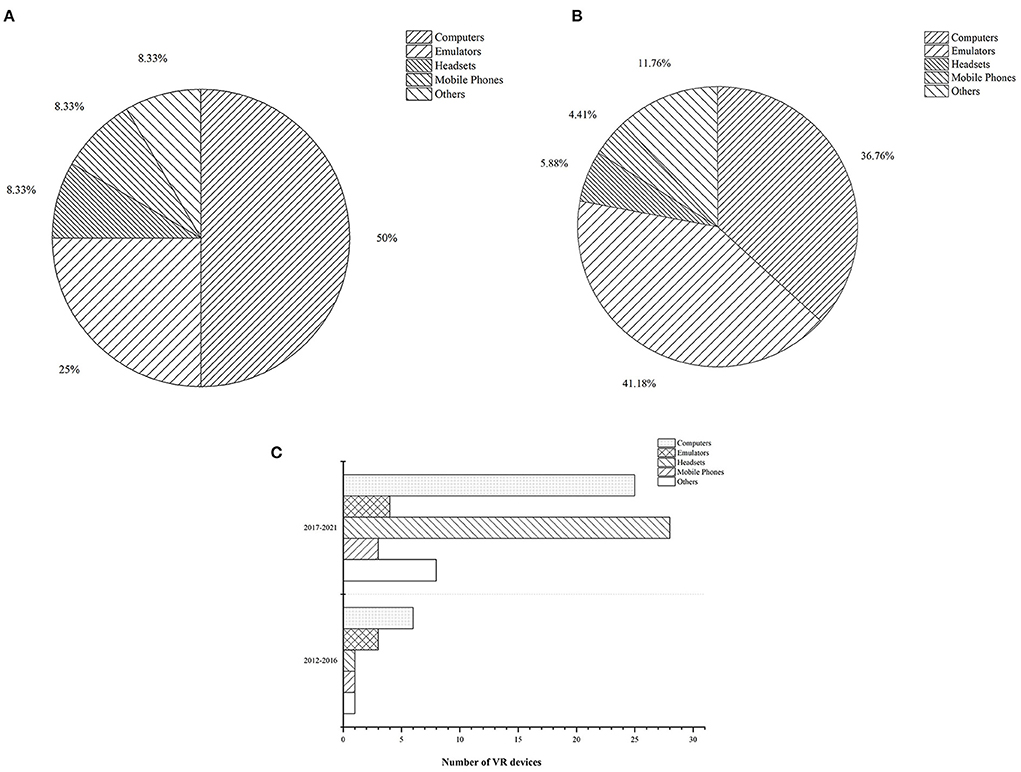
Figure 4. Statistics of VR teaching equipment. (A) VR Equipment (2012-2016). (B) VR Equipment (2017-2021). (C) Number of VR devices.
Research on the effect of VR teaching
The teaching effect is a common concern of researchers. As shown in Figure 5, the researchers used a variety of evaluation methods to evaluate the teaching effect of VR in higher education, including traditional evaluation, embedded evaluation and hybrid evaluation. The traditional evaluation includes questionnaires, test papers and various tests, while the embedded evaluation can be completed in the VR environment. The mixed evaluation includes both traditional evaluation and embedded evaluation. Observing Figure 5, it can be found that when studying the application of VR in higher education, researchers mostly use traditional evaluation to evaluate the teaching effect, a total of 64 papers, accounting for 80% of the research literature. For example, Samosorn et al. used questionnaires and tests to understand the effect of the intervention after training nursing students in the use of VR intervention for difficult airway management (Samosorn et al., 2020). Followed by the embedded evaluation, a total of 9, accounting for 11.25% of the research literature. Four studies used mixed assessment to evaluate the teaching effect, and three studies did not evaluate the teaching effect. In the 80 literatures, the teaching effect of most of the research is positive. For example, the research results of Arif et al. show that in the virtual reality environment, students show stronger concentration (Arif, 2021); However, some research results show that the teaching effect of VR in higher education is not so ideal. For example, Harrison et al. research results showed that in the teaching of surgical preparation, the application of VR technology did not show a perceptible advantage compared with traditional video teaching (Harrison et al., 2017). In addition, this paper also studies the impact of VR technology teaching on students' learning results, and analyzes 80 literatures that were finally screened. The application of VR technology in higher education mainly affects students' learning results by affecting students' behavior (n = 35), followed by affecting students' cognition (n = 22), and finally affecting students' learning outcomes (n = 6) by affecting students' emotional attitudes.
VR research methods
This paper also sorts out and categorizes the research methods of related literature. The number of these articles is larger than the total number of research literature after measurement, because an article may contain more than one research design category, one data collection method and one data analysis method. The research results show that there are 63 empirical quantitative studies, 13 empirical qualitative studies, 29 design-oriented studies, and 5 without methods in the literature studied. The data collection methods used in the research literature mainly include questionnaires, tests, interviews, observations and experiments. The main data collection methods are questionnaires (n = 39) and tests (n = 39). Semi-structured questionnaires are between structured questionnaires and unstructured questionnaires. The answers to the questions include both pre-set, fixed, and standard options types, as well as questions that the respondents can answer freely. Therefore, semi-structured questionnaires have the advantages of both structured and unstructured questionnaires, and such questionnaires are widely used in research surveys. In addition to questionnaires and tests, the data collection methods in some literatures are the interview method (n = 8) and the observation method (n = 5), most of which are used for qualitative research. The data analysis methods used in the research literature mainly include descriptive analysis (n = 25), difference analysis (n = 57) and correlation analysis (n = 2). Difference analysis mainly includes t-test, ANOVA, ANCOVA, chi-square test, Mann-Whitney U-test and other analysis methods, correlation analysis methods include correlation coefficient, regression model, factor analysis and other methods. Among all the 57 articles that used the method of difference analysis, the t-test (n = 24) was the most commonly used method for quantitative data analysis, and the other analysis methods averaged only 10–12 articles. Most of these findings are that VR-generated interventions are positive and improve teachers' teaching effectiveness.
Discussion
Answer to questions
This paper organizes and analyzes the relevant literature on the application of VR technology in the field of higher education. The research results show that the main objects of VR application in the field of higher education are undergraduates, and the majors of application are mainly related to science, engineering and medicine, history, art and others. Humanities and social science majors have relatively few applications. The main devices for VR applications in the field of higher education include computers, headsets, VR simulators, mobile phones and so on. Due to the development of technology, head-mounted devices have become the main equipment for VR applications in higher education. Because researchers are more inclined to use devices that are less expensive and more interactive, allowing users to be highly immersed in a virtual environment. Compared with traditional education, the vast majority of studies show that the application of VR to higher education and teaching has positive effects, mainly by affecting students' behaviors to affect students' learning results, secondly by affecting students' cognition, and finally by affecting students' learning. Affect students' emotional attitudes to affect students' learning results. Analysis of the reasons, due to the immersion and interactivity of the VR environment, VR is often used in higher operability courses in higher education, such as medical anatomy courses, dental and dental repair courses, machine tool operation training courses, and so on. L In addition, scholars mainly use objective test questions and subjective questionnaires to evaluate the teaching effect of VR, and a small number of researchers use embedded evaluation to evaluate the teaching effect. The research results show that the main research method of the researchers to study VR application and higher education is quantitative research, the main data collection methods selected are questionnaires and tests, and most of the questionnaire surveys are mainly semi-structured questionnaires. The data analysis methods used in the research literature mainly include descriptive analysis and variance analysis. Among all 57 articles using variance analysis methods, t-test is the most commonly used quantitative data analysis method.
Suggestions
Based on the relevant findings of this study, researchers put forward the following suggestions, hoping to provide some references for the application of VR in the field of higher education. First of all, VR is mainly applied to undergraduates in higher education, and the applied majors are mainly science, engineering and medical related majors. The application of history, art and other humanities and social science majors is relatively less, so researchers can turn their attention to the teaching of humanities and social science majors. It is hoped that future researchers will make full use of these advantages and deepen the application of VR in the overall field of higher education.
Secondly, it can be seen from the review results that the current VR related devices applied in the field of higher education are mainly computers and head-mounted displays. Compared with the past, the immersion and interaction of devices are improved, but there is still a lot of room for development. The portability of the device is not enough, and students cannot use the device to study anytime, anywhere. Mobile devices such as mobile phones, although portable, must be combined with other devices such as VR glasses to simulate the VR environment. The immersion and interaction of this VR environment Sex will be greatly reduced, and it is expected that researchers in the future can break through the technical difficulties and solve this problem. Third, in the literature studied, only a few researchers have conducted VR training and teaching guidance for students before class. The lack of guidance will cause students to operate equipment irregularly and cause some unnecessary problems. First of all, if students do not receive relevant guidance in advance, they will aimlessly explore VR equipment in class, which not only wastes teaching time, but also has a negative impact on teaching effectiveness. In addition, the screen of the VR equipment covers most of the student's field of vision, and the immersion brought by the equipment is very strong, which is easy to cause 3D vertigo. Therefore, in the process of VR teaching, it is very necessary to provide training or guidance to students. Finally, most researchers need to develop, test, and continuously improve VR educational resources before applying them to teaching, which is time-consuming and labor-intensive. In the future, researchers can develop more professional and mature VR educational resources according to the teaching objectives of different majors in higher education, and directly apply them to the teaching of higher education, promoting the deep integration of the entire higher education teaching field and VR technology.
Limitations
Due to the nature of the review, selection, and filtering process, our work has several limitations. First of all, this paper does not deeply explore the application of VR technology to the various majors in higher education mentioned in the text, but only elaborates on the application of some representative majors. Secondly, this study does not focus on some obstacles when VR is applied in teaching, such as adverse reactions after students use VR equipment, and network conditions of VR equipment. But these obstacles are related to technology, and we believe that the development of technology will solve these problems soon.
Conclusion and future research
In this paper, the researchers focus on the application of VR technology in higher education. The teaching contexts, VR devices, teaching effects, and research methods used in the recent literature on educational VR applications are studied. The results of the review show that people are very interested in the application of VR technology in higher education. Many researchers believe that VR technology is a very useful teaching tool, and they have conducted many experimental studies. But the maturity of VR use in higher education is still uncertain, including the VR technology used and the teaching resources developed by educators. In addition, most researchers use VR technology to teach teaching practice, which also implies that VR technology is mostly used in higher operability majors. This paper also points out the problems and puts forward some suggestions. Our work will continue with an analysis of VR technologies available for higher education, followed by an in-depth survey of higher education workers to gain a more detailed understanding of the current state of adoption. Our goal is to deepen the application of VR in higher education.
Data availability statement
The original contributions presented in the study are included in the article/supplementary material, further inquiries can be directed to the corresponding author.
Author contributions
XD and ZL contributed to conception and design of the study. XD organized the database, performed the statistical analysis, and wrote the manuscript. All authors contributed to manuscript revision, read, and approved the submitted version.
Funding
This paper was supported by Fujian Province Educational Science Plan 2021 key special project for high-quality development of basic education, project name is Fujian Province Robot Education Application Research under the National Intelligent Manufacturing Industry Policy (Grant No. FJWTZD21-06). This paper was supported by 2022 Fujian Provincial Social Science Fund, project title is Research on the construction of foreign language teaching model based on educational robots (Grant No. FJ2022BF015).
Acknowledgments
We thank ZL for his guidance on the manuscript.
Conflict of interest
The authors declare that the research was conducted in the absence of any commercial or financial relationships that could be construed as a potential conflict of interest.
Publisher's note
All claims expressed in this article are solely those of the authors and do not necessarily represent those of their affiliated organizations, or those of the publisher, the editors and the reviewers. Any product that may be evaluated in this article, or claim that may be made by its manufacturer, is not guaranteed or endorsed by the publisher.
References
Alalwan, N., Cheng, L., Al-Samarraie, H., Yousef, R., Alzahrani, A. I., and Sarsam, S. M. (2020). Challengeand prospects of virtual reality and augmented reality utilization among primary school teachers: a developing country perspective. Stud. Edu. Evaluat. 66, 100876. doi: 10.1016/j.stueduc.2020.100876
Arif, F. (2021). Application of virtual reality for infrastructure management education in civil engineering. Edu. Inform. Technol. 26, 3607–3627. doi: 10.1007/s10639-021-10429-y
Chen, L. W., Tsai, J. P., Kao, Y. C., and Wu, Y. X. (2019). Investigating the learning performances between sequence-and context-based teaching designs for virtual reality (VR)-based machine tool operation training. Comput. Appl. Eng. Edu. 27, 1043–1063. doi: 10.1002/cae.22133
Duarte, M. L., Santos, L. R., Júnior, J. G., and Peccin, M. S. (2020). Learning anatomy by virtual reality and augmented reality. A scope review. Morphologie 104, 254–266. doi: 10.1016/j.morpho.2020.08.004
Dyer, E., Swartzlander, B. J., and Gugliucci, M. R. (2018). Using virtual reality in medical education to teach empathy. J. Med. Library Assoc. JMLA 106, 498. doi: 10.5195/jmla.2018.518
Harrison, B., Oehmen, R., Robertson, A., Robertson, B., De Cruz, P., Khan, R., et al. (2017). “Through the eye of the master: the use of virtual reality in the teaching of surgical hand preparation,” in 2017 IEEE 5th International Conference on Serious Games and Applications for Health (SeGAH: IEEE). p. 1–6. doi: 10.1109/SeGAH.2017.7939269
Hoffman, H., and Vu, D. (1997). Virtual reality: teaching tool of the twenty-first century?. Acad. Med. J. Assoc. Am. Med. Colleges 72, 1076–1081. doi: 10.1097/00001888-199712000-00018
Huang, C. Y., Lou, S. J., Cheng, Y. M., and Chung, C. C. (2020). Research on teaching a welding implementation course assisted by sustainable virtual reality technology. Sustainability 12, 10044. doi: 10.3390/su122310044
Jung, E. Y., Park, D. K., Lee, Y. H., Jo, H. S., Lim, Y. S., and Park, R. W. (2012). Evaluation of practical exercises using an intravenous simulator incorporating virtual reality and haptics device technologies. Nurse Edu. Today 32, 458–463. doi: 10.1016/j.nedt.2011.05.012
Kader, S. N., Ng, W. B., Tan, S. W. L., and Fung, F. M. (2020). Building an interactive immersive virtual reality crime scene for future chemists to learn forensic science chemistry. J. Chem. Edu. 97, 2651–2656. doi: 10.1021/acs.jchemed.0c00817
Krokos, E., Plaisant, C., and Varshney, A. (2019). Virtual memory palaces: immersion aids recall. Virtual reality 23, 1–15. doi: 10.1007/s10055-018-0346-3
Moore, P. (1995). Learning and teaching in virtual worlds: implications of virtual reality for education. Aust. J. Edu. Technol. 11:92–102. doi: 10.14742/ajet.2078
Mulla, M., Sharma, D., Moghul, M., Kailani, O., Dockery, J., Ayis, S., et al. (2012). Learning basic laparoscopic skills: a randomized controlled study comparing box trainer, virtual reality simulator, and mental training. J. Surg. Edu. 69, 190–195. doi: 10.1016/j.jsurg.2011.07.011
Murbay, S., Chang, J. W. W., Yeung, S., and Neelakantan, P. (2020). Evaluation of the introduction of a dental virtual simulator on the performance of undergraduate dental students in the pre-clinical operative dentistry course. Eur. J. Dental Edu. 24, 5–16. doi: 10.1111/eje.12453
Rogers, S. (2019). “Virtual reality: the learning aid of the 21st century” in Secondary Virtual Reality: The Learning Aid of the 21st Century, New York.
Ryan, M. L. (2015). Narrative as Virtual Reality 2: Revisiting Immersion and Interactivity in Literature and Electronic Media. Baltimore: JHU press.
Samosorn, A. B., Gilbert, G. E., Bauman, E. B., Khine, J., and McGonigle, D. (2020). Teaching airway insertion skills to nursing faculty and students using virtual reality: a pilot study. Clin. Simulat. Nursing 39, 18–26. doi: 10.1016/j.ecns.2019.10.004
Shin, D. (2018). Empathy and embodied experience in virtual environment: To what extent can virtual reality stimulate empathy and embodied experience? Comput. Hum. Behav. 78, 64–73. doi: 10.1016/j.chb.2017.09.012
Keywords: virtual reality, higher education, empirical research, virtual environment, immersion learning
Citation: Ding X and Li Z (2022) A review of the application of virtual reality technology in higher education based on Web of Science literature data as an example. Front. Educ. 7:1048816. doi: 10.3389/feduc.2022.1048816
Received: 20 September 2022; Accepted: 02 November 2022;
Published: 17 November 2022.
Edited by:
Ana Luísa Rodrigues, University of Lisbon, PortugalReviewed by:
Antonio Matas-Terron, University of Malaga, SpainChengjiu Yin, Kobe University, Japan
Hai Zhang, Northeast Normal University, China
Copyright © 2022 Ding and Li. This is an open-access article distributed under the terms of the Creative Commons Attribution License (CC BY). The use, distribution or reproduction in other forums is permitted, provided the original author(s) and the copyright owner(s) are credited and that the original publication in this journal is cited, in accordance with accepted academic practice. No use, distribution or reproduction is permitted which does not comply with these terms.
*Correspondence: Zhe Li, bGl6aGVyaXRldHVAMTYzLmNvbQ==
 Xiaoqin Ding
Xiaoqin Ding Zhe Li
Zhe Li